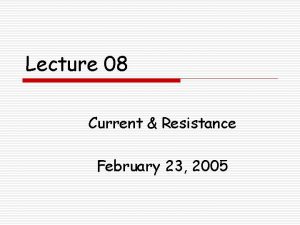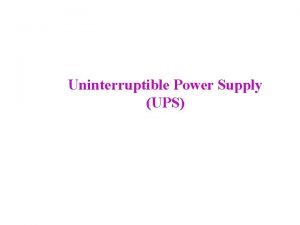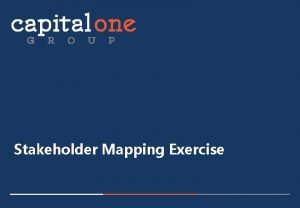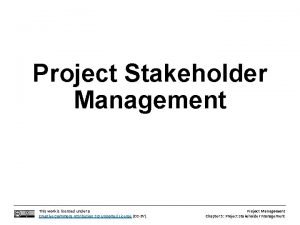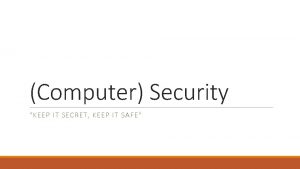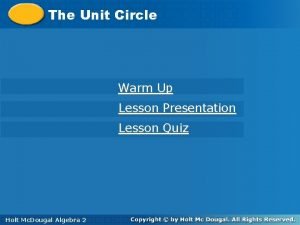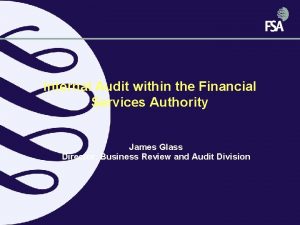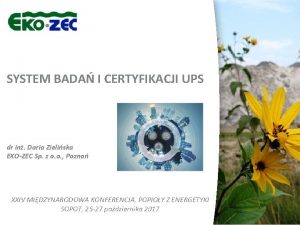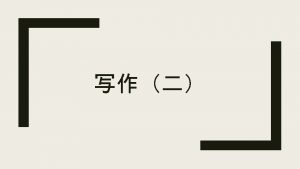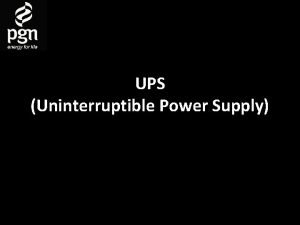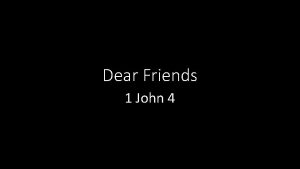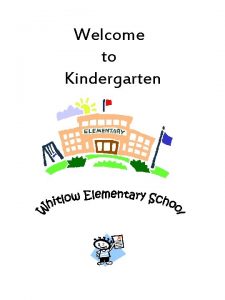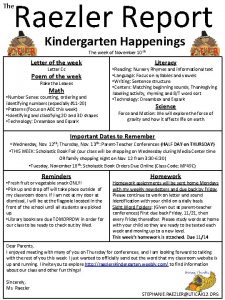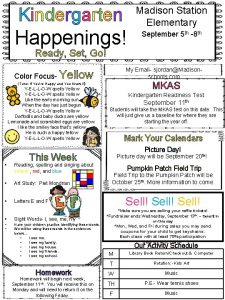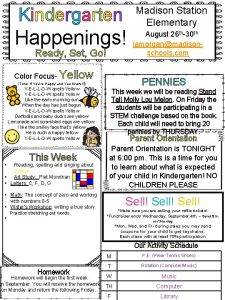Kindergarten Keep Ups Ms Machins classroom happenings Dear










- Slides: 10

Kindergarten Keep Ups Ms. Machin’s classroom happenings Dear Parents, Welcome to Kindergarten! It is going to be an exciting and fun filled year for you and your student. This year your students will grow and learn in an environment that is nurturing but also academically challenging. This is the first news letter of many that you will receive throughout the year. These “keep ups” are sent out to keep you informed on what we are doing in your classroom and how your child’s lives are being enriched here at school. This first issue is going to layout some of my teaching strategies and philosophies so that you will know exactly what kind of classroom your student enters into everyday! In this particular issue I will focus specifically on how math is instructed in the classroom. With all of the changes in state standards you may have a lot of questions, hopefully the next couple of pages will answer your questions and make you feel at ease. You will also be pleased to hear that the PTA has given my class $1, 500 to outfit my class with all of the math materials that I need to teach your students to be mathematicians! Warmest Welcomes, Ms. Machin Got Questions? Email at: machinj@spu. edu

What are we learning? In the state of Washington we are required to teach math in alignment with the Common Core State Standards. A standard is skill or set of skills that students should be able to do and understand by the end of each grade. Instead of covering an introduction to a huge variety of skills and concepts we are going to be focusing on just a few standards at a rigorous level in order for your students to have a better understanding of the concepts that they will need to build upon as the progress through school. I will be teaching the areas that Kindergarteners need the most. In Kindergarten students should spend the majority of their instructional time focused on whole numbers. Students should be learning how to use numbers verbally and use written numerals to identify a number of objects, or count out a certain number of objects. Eventually students will start to add and subtract numbers of small quantities. The other important goal of math in kindergarten is teaching the foundation of basic geometry. Student should be able to name, describe, and identify basic two dimensional and three dimensional shapes. They will use these shapes to better understand their surroundings and they will be able to make complex shapes out of the shapes that they know.

Common Core State Standards Counting and Cardinality This is where we will spend most of the first semester • Students must be able to count to 100 in a sequence by ones and by tens. They can start counting from any number in a sequence. They can write their numbers up to 20 and identify a number of objects using written numerals -This is a skill that we have already started and work on everyday during calendar time and we start math everyday by counting on our number line and writing our numbers on our white boards. Soon we will start using our floor number line to start counting from any number. Understanding the counting sequence is crucial to being able to understand cardinality and eventually operations. • Students must be able to count and pair each number with an object and be able to identify that each object is one number name. After they count objects they should understand that the last number is the total number of objects. They should be able to tell how many objects there are up to twenty. -This is what we are currently working on in math small groups. We use various kinds of colored counters to help students to understand that each counter is only one object. This is done by asking questions such as can you count five bears, or giving them a set number of counters and asking the students how many counters are there. The students are asked to touch each object as they count so that can rationalize that when they touch an object that is “one”. Eventually we want students to be able to look at a set of object and know how many without having to count each individually. They will use the Cuisinare jr. rods for showing and practicing this. This skill is important because when we teach addition and subtraction they will do so by using counters to add and subtract. • Identify if numbers are bigger or smaller and be able to compare numbers to twenty using written numerals. -We have only just started this skill in discussion, the students are learning that the number that comes “next” in the counting sequence is bigger than all of the ones before it. We will start using manipulatives to compare groups of objects. Eventually we will move to where students can write their numbers and tell which one is the larger of the two. I will also have a center with a game for this skill.

Operations and Algebraic Thinking Once the students know their numbers to ten and can match sets to ten we will start learning how to add and subtract. • Students should be able to add and subtract numbers using objects and manipulatives up to ten. They should also be able to take apart and put together numbers to ten and use numbers to nine to add up to ten. Finally to be fluent their addition and subtraction facts to 5. -We will start learning to add first. I will start teaching addition with fingers, counters, dice, Unifix cubes, and a modified abacus called a Rekenrek. We will also us addition when we are counting things throughout the day. We will use dice to give the students two numbers to put together and they will count how many there are in all. They can also use dominoes. I will do the same thing with subtraction. Eventually students can solve verbal word problems up to ten using manipulatives and they will switch from using just manipulative to writing numbers and number sentences. This will help students to eventually memorize their addition and subtraction facts to 5, We want students to understand why addition and subtraction equations give them specific answers and that numbers can be in a different order in an equation but it will still equal the same before they have the facts memorized. If your student understands the numbers they will have an easier time taking on more complex numerical tasks. Number and Operation in Base Ten • Students should be able to break apart numbers from 11 -20 into tens and ones in order to gain a better understanding of place value. - We will start to teach this after the students have learned their numbers to ten. We will use our ten frames, and our Rekenreks to begin teaching place value. Students will learn 11 is a set of ten and then one more and the same with all of the other teen numbers and that twenty is two whole sets of ten. We can do this by building up our numbers on our ten frame and by taking apart numbers on our Rekenrek. Eventually students will be able understand that the number 15 is one set of ten and then five more. We will use the class fish tank ten frame for group practice.

Measurement & Data • Students should be able to describe things that are measurable and compare two measurable things. -This is something we can start as soon as the students understand cardinality and counting objects to at least 5. We will not be using actual rulers to measure anything in kindergarten. Instead students learn how to use unifix cubes and colored tiles to count and measure objects. We will start our by measuring small things like a pencil or crayon. We also have special manipulatives just for measuring like rubber worms. We will answer questions like how many cubes or tiles long is your pencil and students will write those numbers on their paper. Once students have an understanding of bigger or smaller numbers they will be able to tell which object is bigger not just by looking at it but by knowing that one number measurement is larger or smaller than the other. • Sort and classify objects and count the number of objects in each category. - The students will start sorting objects by their color, shapes, and size. They will learn to differentiate between objects that are similar but different. Eventually they will be able to use their counting skills to count the number of objects that are in each of the groups that they sorted. As a class we will do sorting and begin graphing our data that we collect I will also have out a sorting center in the classroom for students to do independent discovery in this area. Geometry • Be able to identify and describe geometric 2 -D and 3 -D shapes. -The students will start geometry by learning the names of the shapes and learning that if you change the shape or length of a side the shape is still the same. I will teach the shape names using pattern blocks and models of the 3 -D shapes. We will also use the Geoboards to stretch and contort shapes. We will then start to look for the shapes that we see in the world around us. • Understand that you can use less complex shapes to make more complex shapes through building, drawing, or creating. - We will start to teach this skill by using drawings. We will make pictures on our whiteboards using shape. We will also use pattern blocks to make bigger shapes and creations. Finally we will use the magnetic polyhedrons to build 3 -D shapes out of 2 -D shapes.

How I Teach My goal in teaching mathematics to your students if for them to gain a better understanding of the concepts I have just described for you and be able to build upon those concepts as they progress throughout school. I want to give them the tools so that they will feel confident in their mathematical abilities and persevere through solving any problem that they face in their schooling. In order to make sure language does not change myself and the students will use appropriate academic language when we discuss math. Lev Vygotsky is one psychologists whom I pull a lot of my teaching strategies from. He believed that students need to be in a cooperative learning environment. Your student has a limit to what they can learn on their own abut they are capable of achieving much more with appropriate guidance from other classmates, myself and you. Students can learn a lot from each other so I will often have students explain answers in their own words and we can discuss it as a class. Jean Piaget is another learning theorist who plays a role in my instruction. Piaget believed that your students are constantly making meaning of the things around them and then building and changing that meaning as they gain more information. We use the information that we already have and have already learned and we build upon in to make new meanings of new things. Due to this theory I allow time in my classroom for students to reflect on learning so that they make their own appropriate meanings that will benefit them in the future of their learning. I am focused on planning my lessons so that your students can learn to be able to reason about numbers on their own. In the future they will be able reason about more then just counting and adding. They will use their adding skills and knowledge to someday reason about multiplication. As a kindergarten teacher my instruction is devoted to laying the proper foundation for all learning that will occur in the future.

How my math class is run My classroom is an open and nurturing place for students to learn. I believe that learning should happen through hands on activities and learning centers. The manipulatives that they students use for learning time will be stored throughout the room and taken out by me and distributed only during instruction/ work time. That being said there will also be some manipulatives that will be out for students to use during center time so that they can make some of their own discoveries and meaning. In kindergarten learning happens through play so allowing students time to play with materials is appropriate, as long as they understand that during work time they are not to play. We will have computers in the classroom with software for learning and practicing math skills. They will also be using several online programs that are chosen by the school and myself and are deemed safe. The computers will be a center choice and if the students are abusing the privilege by not using it appropriately than they will have to lose that time. We will not use calculators in my class because students need to learn the basic math skills. I request that you do not let them use a calculator at home to solve math problems as that disrupts their mathematical understanding.

Class Materials In the spirit of being prepared for anything, I did not spend all of my given budget to save in case anything needs to be replaced or fixed.

Math & Literacy Small group area Learning Table Math Learning Center Shelves

References "Common Core Resources. " Common Core Resources /. N. p. , n. d. Web. 23, Nov. 2014. <http: //www. insidemathematics. org/commoncore-resources>. "Mathematics Common Core State Standards. " Mathematics Common Core State Standards. N. p. , n. d. Web. 17, Nov. 2014. <https: //www. k 12. wa. us/Core. Standards/Mathematics/default. aspx>. Karp, Karen S. , Sarah B. Bush, and Barbara J. Dougherty. "13 Rules That Expire. " Teaching Children Mathmatics 21. 1 (2012): 18 -25. Print. Van De Walle John. Elementary and Middle School Mathematics: Teaching Developmentally. 8 th ed. Boston: Allyn and Bacon, 2004. Print.
